 Photo 1
Photo 1
Badly cockled poster paint handprint shows buckles at window mat edge.
Watercolor papers are sold with both clean cut edge—as from a watercolor block—and deckled edge as single sheet. Allowing the beauty of uneven deckled edges to remain visible as part of the framing presentation is called float mounting the art, and can be a dramatic and attractive way to showcase any original. Highly cockled papers that have been painted without pre-stretching will not lie flat enough for float mounting. If the edges of the watercolor paper are too wavy for a traditional window mat (photo 1) or a float mount to be used then a sink mount is the only option. A flat watercolor—or one with only gentle waves—is the best candidate for a float mount, and a pedestal float is the most dramatic and easiest to achieve.
 Photo 1
Photo 1
Badly cockled poster paint handprint shows buckles at window mat edge.
Preservation Materials
When framing any original or irreplaceable art only noninvasive preservation materials should be used. That means cotton rag boards, UV-protective (or museum glass) and reversible mounting technique such as cooked paste starch hinges. It is the job of a hinge to break before the art tears in the event a frame falls to the floor or is dropped during transport. Hinging tapes have been widely available for years with water activated gummed and pressure-sensitive (P-S) adhesives, in a variety of weights from sheer mulberry paper to heavy threaded linen. These commercial tapes may be suitable for lesser valued items but should never be used for any original art and no professional custom framer should even suggest them.
Gummed tapes are easily removed after dry by reactivating with water, but are far too strong to tear if the frame were to fall. Even water activated linen—considered preservation quality for hinging by many—can buckle and damage paper over time (photo 2). When anything other than water is required for hinge removal—such as mineral spirits or chemical solvent—it is not a preservation product and should be avoided. Even water soluble tapes only remove the tissue carrier and not adhesive saturation when removed. In as short as ten years this adhesive can chemically react and cross-link with atmospheric pollutants rendering the new adhesive insoluble and nonremovable, impacting the value of the art forever.
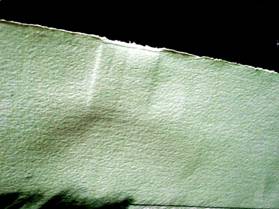 Photo 2
Photo 2
Gummed linen hinges restricted paper expansion causing visible damage over time.
Pressure-sensitive adhesives (PSA or P-S) are a permanently tacky substance that bonds at room temperature, with the application of manual pressure. P-S tapes should never be placed in direct contact with artwork regardless of whether they are acid free or not, as damage can occur from all P-S adhesives over time. There are many water activated and pressure-sensitive tape products commercially available to artists, so choose wisely if you value your art.
Starch Pastes
Natural starches are used to make water soluble, noninvasive, neutral pH adhesive paste for hinging. Gluten free wheat and rice vegetable-based starches are best for preservation hinging with rice starch forming a medium strength bond and wheat starch forming the stronger bond necessary for float mounting. Both wheat and rice are available as ready-to-cook powder, precooked powder, and precoated paper strips, so there is no excuse for not hinging original art with natural starch and Japanese paper hinges rather than commercial pressure-sensitive hinging tapes.
Lineco is a good source for preservation materials including wheat and rice starch powder. Lineco Hayaku is a long fiber hinge product with a dry, acid free, water activated, starch adhesive on one side capable of holding up to 15 pounds of weight when properly mounted. Be careful to allow the water to naturally soak up into the hinge from beneath rather than brushing water directly onto the adhesive as you can actually remove adhesive during the process. Lineco Abaca.sa is a very strong long fibered, manila hemp tape with an acrylic adhesive that is permanent and non-yellowing. Though not for hinging art it is perfect for book hinging window mat to backing board.
*****************************************
Wheat Starch Recipe (as possible sidebar)
Lineco purified, uncooked, wheat starch powder is easily prepared by mixing 1 part starch to 5 parts distilled water.
*****************************************
Hinges
The three hinges used in float mounting are V-hinge, S-hinge and pedestal hinge (photo 3). The major visual difference in them is the distance from the backing which in turn impacts the required depth of the frame with glass. The V-hinge is simply folded and attached to back of the art on one edge then held to the backing board on opposite hinge edge (diagram 1). A simple V-hinge is very weak and can peel off with gravity. A reinforced V-hinge adds a supportive cross piece which makes it stronger, but may still pull the art from the backing.
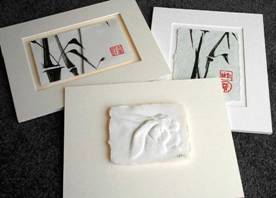 Photo 3
Photo 3
(clockwise from top L) S-hinge, V-hinge, Pedestal hinge
The basic S-hinge is very strong when held and transported upright, but is subject to peel failure if the frame is rotated or mishandled and the weight of the art is allowed to pull against the hinge. The S-hinge is first mounted to the back side of the art, weighted and allowed to dry. Slots are cut in the backing board at the proper height and just slightly wider than the hinge. The sharp edges of the backing must be rounded to prevent cutting the rice paper hinges either when they are being passed through or during handling of the framed image. They are then glued to the back of the mount board (diagram 2). This method has no spacer—lifter—behind the art and watercolor rests directly on the backing.
The raised platform or pedestal hinge allows free floating of artwork mounted to a raised platform which in turn is fused to the decorative backing board (diagram 3). The platform is cut smaller than the art so it will not be visible at the edges and hinges are pasted to the back of the art—top, sides and bottom—weighted and allowed to dry. The dried hinges are then pasted over the platform and when dry the platform is fused to the decorative backing. This method allows the art to hover above the backing and float inside the window mat.
*****************************************
Making Hinges from Full Sheets (as possible sidebar)
The best hinging papers are handmade, long fiber, Japanese 100% kozo fibers which are available in various weights from mulberry (heavyweight), kizukishi (medium weight), toso tengujo and kozogami tsuru (lightweight). Hinges are very light and strong when dry, but are easily pulled apart when wet, so hinges are easy to make from full sheets.
*****************************************
Step-by-Step Platform
The original 22x30" full sheet watercolor is by artist Bob Rowland, New Orleans, LA and was done on 140#CP Kilimanjaro natural white paper. Assemble wheat starch powder, squares of blotter paper and spun polyester (Pelon), teaspoon, microwavable dish, natural bristle brush and plate for applying paste to hinge (photo 4). Cook paste as directed and tear hinges in preparation.
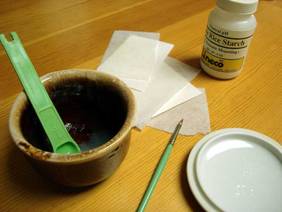 Photo 4
Photo 4
Assemble wheat starch powder, squares of blotter paper and spun polyester (Pelon), teaspoon, microwavable dish, natural bristle brush and plate for applying paste to hinge.
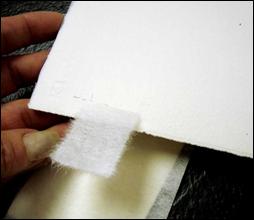 Photo 5
Photo 5
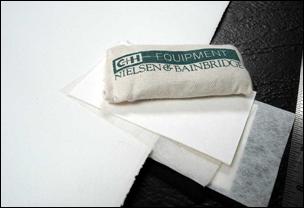 Photo 6
Photo 6
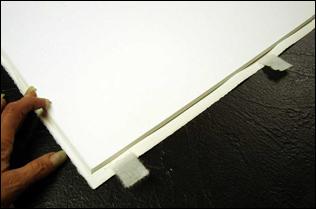 Photo 7
Photo 7
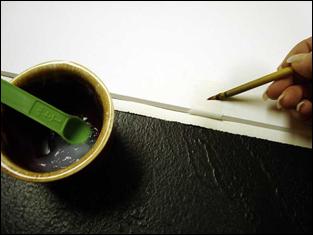 Photo 8
Photo 8
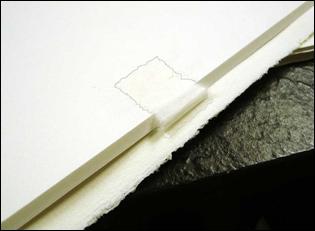 Photo 9
Photo 9
 Photo 10
Photo 10
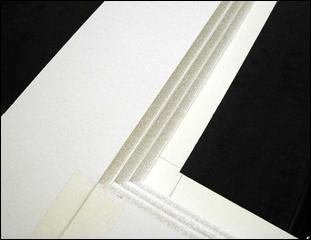 Photo 11
Photo 11
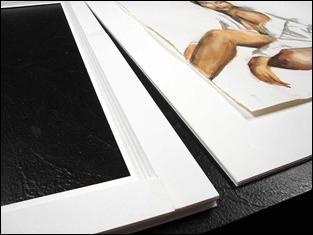 Photo 12
Photo 12
 Photo 13
Photo 13
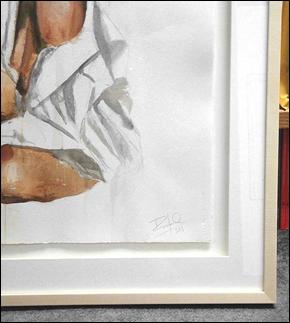 Photo 14
Photo 14
Starch hinging does indeed have a learning curve, but so does painting with watercolors. If floating a deckle edge painting is desired the platform version is the easiest to mount and align. Mats may be any width and allow at least ½" between deckle and mat.
END
Copyright © 2013 Chris A Paschke
For more articles on mounting basics look under the mounting section in Articles by Subject.
Additional information on all types of mounting is found in:
The Mounting and Laminating Handbook, Second Edition, 2002,
The Mounting And Laminating Handbook, Third Edition, 2008 and
Creative Mounting, Wrapping, And Laminating, 2000 will teach you everything you need to know about getting the most from your dry mount equipment and materials as an innovative frame designer.
All books are available from Designs Ink Publishing through this website.
Chris A Paschke, CPF GCF
Designs Ink
Designs Ink Publishing
785 Tucker Road, Suite G-183
Tehachapi, CA 93561
P 661-821-2188
chris@designsinkart.com